#author process
Explore tagged Tumblr posts
Note
Congratulations on your author debut, I'm so excited for your book!! 😇💕
Would you consider talking about the whole process of becoming a book illustrator /children's book author?
Thank you so much, I really appreciate it!! And I'd be happy to share the process!
It all started for me with my 3dTotal artbook. 3dTotal is a small publisher in the UK, and they mainly focus on collections of artists' work. They use Kickstarter to fund each book, and my agent (the amazing Seth Fishman at Gernert) discovered me through the Kickstarter for my artbook Windows to Worlds!
He asked if I had any interest in working on graphic novels or picture books, and I had already been thinking about picture books! He found me my first picture book project with Penguin Workshop, Mother of Sharks, written by the awesome Melissa Cristina Márquez, which came out last year!
While I was working on Mother of Sharks, I was also talking with him about developing The Bakery Dragon, based of course on this painting, which was (and is) one of my proudest artistic moments.
For a little background on the painting, I painted it right after a really challenging couple of months medically - I was dealing with medical complications from my chronic illness for about 6 months, and I wasn't able to finish a single painting the whole time, I was just too exhausted from hospital visits and being in pain. That painting was the first piece I was able to actually complete (both emotionally and literally) in about half a year. So it always held a really special place in my heart, and I really wanted to keep living in that little world. I think there's something in it that is very special to me, about being outside in the cold, seeing warmth and love through a glass barrier, and wanting desperately to reach it.
With Seth's guidance, over a couple months, I developed a pitch for it. The script developed slowly alongside the designs for characters, locations, etc.
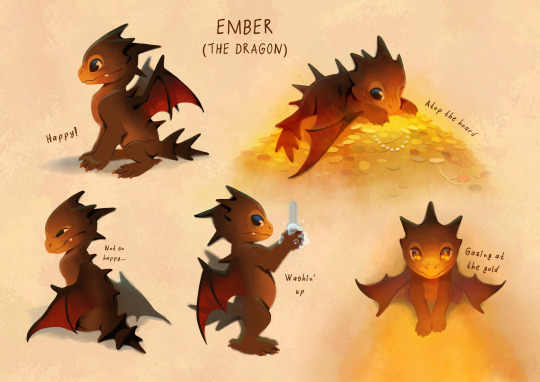
(Early version of Ember above! He has changed a bit!)
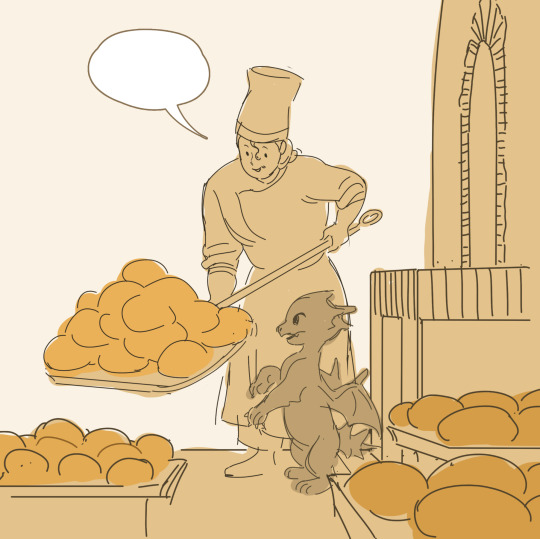
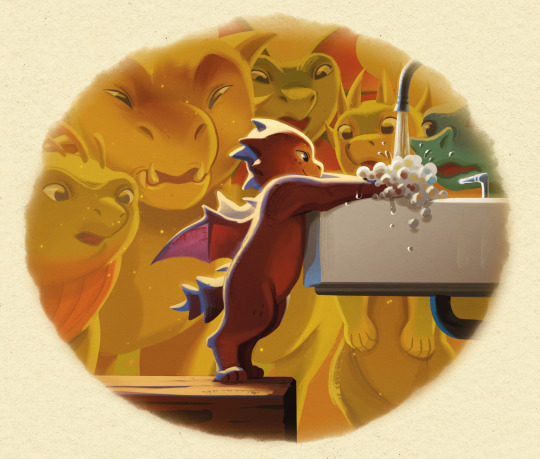
I thought I had already read a lot of picture books, I've always loved them, but I read hundreds and hundreds during this process. There is something uniquely fun and challenging about telling a complete narrative in 48 pages (which is already a long picture book, many are 32!) My book also pulls some elements from comics, such as speech bubbles, which I found to be incredible assets for humor and character development.
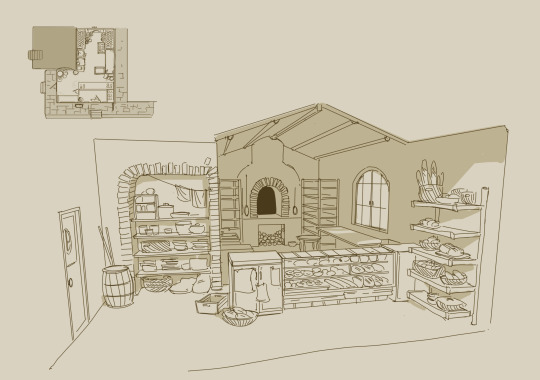
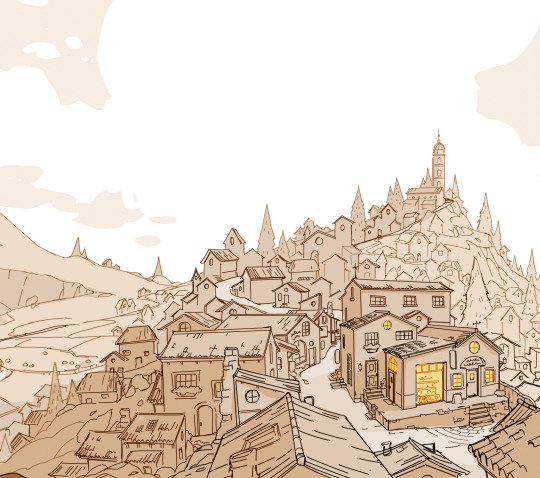
My pitch included designs, some early example spreads, and a rough script with story beats and jokes! My agent took it out into the world, and the publisher we ended up going forward with was Knopf, an imprint of Penguin Random House! I absolutely love the Knopf team and the beautiful books they put out! My editor, Katherine Harrison, really understood what I wanted to accomplish and has been so incredibly helpful in her guidance!
And from there... through rewrites, dialog adjustments, and lots and lots of drawings, it became a book! I'm happy to answer questions about the process! I'll leave you guys with a little preview from the interior of the book! (And of course you can pre-order it here, gotta learn the author skill of always including that link haha!)
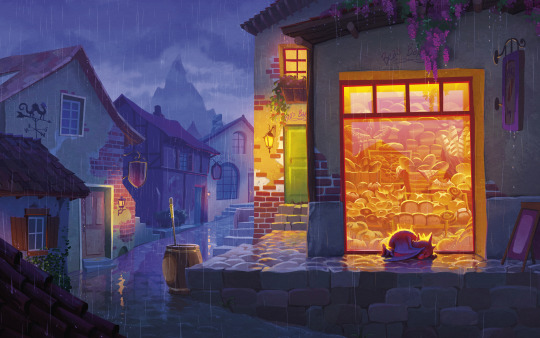
601 notes
·
View notes
Text

the holy grail types of fanfic
#writerscommunity#enemies to lovers#creative writing#writers life#fanfiction#archive of our own#ao3#ao3 writer#ao3feed#ao3 fanfic#fiction writing#female writers#writers on tumblr#my fic#original story#original character#fanfic writing#femme fatale#fanfic#enemies to lovers trope#writing tropes#character tropes#dark romance#romance novels#novel writing#indie author#fiction#fanfic meme#writing memes#creative process
53K notes
·
View notes
Text
Writing Advice:
1. Write what's in your heart
2. Wait, hold up
3. THIS is what's in your heart?
4. Dear god
5. Your poor characters.
6. Why is there so much blood and death?
#writing advice#books#writing#writersnetwork#writers#writers on tumblr#writing community#author#writerscommunity#writers life#tumblr writing community#writer problems#writer things#writers of tumblr#writer#writing process#lists by authors#unknown contributors
13K notes
·
View notes
Text
Creating Emotionally Devastating Scenes.
Crafting a scene that earns the total sympathy of your readers can be challenging, but it's not impossible. Most emotionally devastating scenes fail at two things, but when these are done right, the results can be powerful.
⚪ The Important Concepts for Writing an Emotionally Devastating Scene
1. The Build-Up,
2. Breaking the Dam.
Before I explain these concepts, let me share a case study.
⚫ Case Study
I wrote a story about a young orphan named Jackie and her younger brother. Their village was burned down, leaving them as the only survivors.
For the next few chapters, readers followed their painful journey and their struggle to survive. The younger brother had a heart problem, and Jackie vowed to become a cardiologist to save him.
She was very ambitious about it, but at the time, it was very ironic. Later in the story, when they encountered a tragic living condition with a family, the brother died while telling his sister how much he missed their parents.
When her brother was fighting for his life, she was sent out of the room, only to be let in again to see his cold, lifeless body.
⚪ Explanation of Concepts
1. The Build-Up
The build-up is extremely important when you aim to convey strong emotions. Here's a secret: if you plan for a scene with strong emotions, start leaving breadcrumbs from the very beginning of the story.
Take the previous case study. I carefully built up their journey so people could easily relate and feel the pain of the older sister during her brother's sudden death.
You need to give the situation enough reason to feel utterly hopeless and devastating. Gradually cultivate the tension until it's ready to let loose.
⚫ Understanding the Use of Breadcrumbs.
Breadcrumbs in stories ensure you utilize the time you have to build up certain emotions around your characters.
At the beginning of my story, Jackie’s fate was already pitiable, but she survived every hurdle. This gave the readers enough to feel for her while still leaning away from the outcome. When I built enough, I introduced her brother's sudden death.
Hence, leave your breadcrumbs while leaning away from the outcome.
⚪ How to Properly Leave Breadcrumbs
When building up your story, consider these elements:
☞ Character Relatability: The characters need to be realistic to draw readers into the story. This helps readers invest themselves in your story.
☞ Realistic Emotional Pain: Just as characters need to be relatable, their emotions need to be realistic and not appear forced.
☞ Create a Strong Emotional Attachment: Give them something they care about or that has the power to ruin their lives in any way. It could be something that makes them happy or something their happiness relies on. When it's time, snatch it away without remorse.
☞ Have a Backstage Struggle: This struggle keeps readers occupied, so they won't see the outcome coming. For example, Jackie’s constant struggle to find food and shelter keeps readers engaged while the impending tragedy looms in the background.
☞ Attach Believable Elements: For a realistic character, emotion, and struggle, attach believable elements. It could be death, ailments, sickness, disorder, disappointment, failure, etc.
Now that we've covered the build-up, let's move on to the next crucial part.
2. Breaking the Dam
This is when you make your readers feel the strong emotions alongside your characters. All the tension you’ve been building up is released, making all emotions come into play.
☞ Break Your Strong Attachment: Cut off your strong attachment from your character when they least expect it or at a point when they couldn't use more struggles (i.e when they are helpless).
This will not only evoke readers’ emotions but also pique their curiosity as they wonder how the character will survive the situation.
☞ Description of Sensory Details to Invoke Emotions: The advice of "show, don't tell" will be really helpful here. It's crucial to ensure that the final execution matches the build-up.
A well-crafted build-up can fall flat if the emotional release isn't handled effectively. To avoid this, blend the climax seamlessly into the narrative, making it feel natural and impactful.
Reblog to save for reference! 💜
#writing#writeblr#writers on tumblr#writer#writers and poets#writerscommunity#writing community#wattpad#ao3 writer#a03 writer#writers of tumblr#aspiring author#aspiring writer#writing advice#writing blog#creative writing#writing discussion#writing encouragement#writing guide#writing help#writing ideas#writing journey#writing life#writing motivation#writing novels#writing on ao3#writing process#writing resources#writing reference#writing requests
2K notes
·
View notes
Text
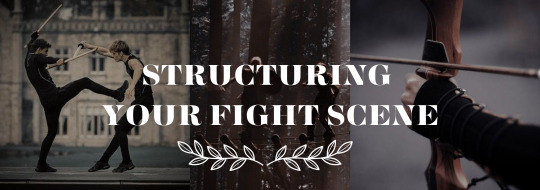
Structuring Your Fight Scene
adapted from <Writer's Craft> by Rayne Hall
Suspense
Show your characters gearing up, readying themselves.
The pace is slow, the suspense is high (use suspense techniques)
Provide information about terrain, numbers, equipment, weapons, weather.
May have dialogue as the opponents taunt each other, hurl accusations, or make one final effort to avoid the slaughter.
Don't start too early - we don't need to see the hero getting out of bed, taking a shower and having tea.
2. Start
Fighters get into fight stance: knees slightly bent, one leg forward, abdominal muscles tensing, body turned diagonally, weapons at the ready.
Each side will usually try to be the first to strike, as this will give them advantage.
The movements in this section need to be specific and technically correct.
3. Action
This section may be quick or prolonged. If prolonged, no blow-by-blow descriptions are needed.
Focus on the overall direction of the fight
Make use of the location to make characters jump, leap, duck, hide, fall, etc.
Mention sounds of weapons
4. Surprise
Something unexpected happens: building catches fire, a downpour, relief force arrives, staircase collapses, bullet smashes into the only lightbulb and everything goes dark, hero losses his weapon, etc.
Add excitement, raise the stakes.
5. Climax
Both sides are tired and wounded
The hero is close to giving up, but is revived with passion
Move to the terrain's most dangerous spot: narrow swining rope-bridge, a roof-edge, sinking ship, etc.
Don't rush the climax! Hold the tension
6. Aftermath
The fight is over: bes buddies lying dead, bandaging, reverberating pain, etc.
Use sense of sight and smell
The hero may experience nausea, shaking, tearfulness or get sexually horny
Fight scene length
Historical/adventure/fantasy: 700-1000w
Romance: 400-700w
#writing#writers on tumblr#helping writers#writeblr#creative writing#let's write#writers and poets#writer on tumblr#creative writers#resources for writers#writer things#writer stuff#author#writer community#writer problems#fight scene#poets and writers#writers block#female writers#writerscommunity#writers life#writers community#write#writers#authors of tumblr#writer#writing process#writing advice#writing inspiration#writing community
4K notes
·
View notes
Text
BTS -2: Accountability

Accountability is important in all things but when you write for yourself it’s a harder feat to hold yourself accountable. You wake up in the morning and there are a million things that seem more urgent than you writing. Many of them will be, but that doesn’t mean that you should just ignore what your goals are. Crazy I know right? Going for your goals and holding yourself accountable? In this economy? But I digress. I think in some ways putting my whole writing process on Medium is a good way to be transparent and also hold myself accountable. There’s a bit of a learning curve, and I’m not really the biggest fan of medium’s word processors… let’s call them quirks. I write and I cannot format what I wrote in the way I want, but these are problems that all writers have to contend with in the 21st century. You could write up an amazing-looking manuscript, and then when you transport it to show it to an editor or to throw it online it boom! You look like a child who tried to write a book with Play-Doh. Everything is all over the place, there are random spaces and indents. No paragraph start where there was in the original and you feel like your brain is about to explode. It’s rough. Well, it’s not just you. It’s all of us. It’s by design. Every company wants to have a different UI (user interface) and be the sole program that you use to write, so they make it just a little infuriating for you to switch to something else. Their way of further cementing in your mind is that they are the superior way to write. I have news for you, it doesn’t matter what program you use. What matters is you. That you are writing and continuing the story. Whatever you are most comfortable with is what you should use. That doesn’t mean that you shouldn’t test out other methods. I often try different programs and even take breaks from the digital all-together and write in notebooks and journals. Do what’s best for you. Above all else, hold yourself accountable to the work and getting it finished, because an unfinished story doesn’t do anyone any good.
1 note
·
View note
Text
Maybe we’re not finishing our stories because we don’t want them to end.
#andmaybeitsmaybelline#writing is hard#writing problems#writing thoughts#writing#writer problems#author#writing process#writblr#writers on tumblr#writerscommunity#writing community#writing life#writer stuff
1K notes
·
View notes
Text
Ultimate "Know Your Character Inside Out" Template
The ultimate template for creating a character, without losing your mind, while you're at it.
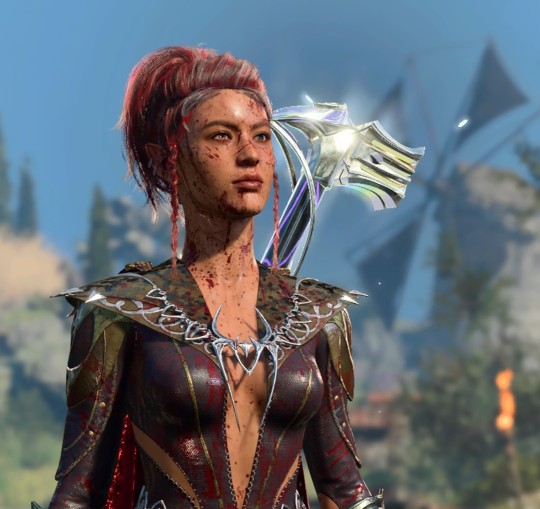
Character Background Template ... (open)
1. Name:
2. Age:
3. Gender & Pronouns:
4. Physical Appearance:
- Hair color:
- Eye color:
- Height:
- Build:
- Distinguishing features (scars, tattoos, etc.):
5. Background and Upbringing:
- Where were they born and raised?
- What was their family structure like (parents, siblings)?
- Describe their childhood environment and upbringing.
- Were there any significant events or traumas in their past?
6. Education and Skills:
- What level of education did they receive?
- Did they excel in any particular subjects or skills?
- Have they pursued any additional training or education since then?
7. Personality Traits:
- Describe their personality in a few words.
- What are their strengths and weaknesses?
- How do they typically react under stress or pressure?
8. Motivations and Goals:
- What are their short-term and long-term goals?
- What drives them to pursue these goals?
- Are there any fears or insecurities that motivate or hinder them?
9. Relationships:
- Who are the most important people in their life?
- How do they interact with family, friends, and acquaintances?
- Do they have any romantic interests or significant relationships?
10. Past Experiences:
- Have they faced any major challenges or setbacks in the past?
- How have these experiences shaped their beliefs and values?
- Have they experienced any significant losses or tragedies?
11. Worldview and Beliefs:
- What are their core beliefs and values?
- How do they view the world around them?
- Are there any cultural, religious, or philosophical influences in their life?
12. Inner Conflict:
- What internal struggles do they face?
- Are there any unresolved issues from their past that continue to affect them?
- How do these inner conflicts impact their decisions and actions?
13. Connection to Outer Conflict/Plot:
- How does their personal journey intersect with the main plot or external conflict?
- What stakes are involved for the character in the larger story?
- How do their goals and motivations align (or conflict) with the central conflict?
(Shorter) Knowing Your Character Inside Out Checklist
Personality Traits:
- Introverted/Extroverted
- Optimistic/Pessimistic
- Assertive/Passive
- Empathetic/Self-centered
- Logical/Emotional
- Adventurous/Cautious
- Honest/Dishonest
- Ambitious/Content
Beliefs and Values:
- Religious beliefs (if any)
- Moral code
- Political beliefs
- Views on relationships
- Attitude towards authority
Fears and Insecurities:
- Common fears (spiders, heights, etc.)
- Deep-seated insecurities (failure, rejection, etc.)
- Traumatic experiences (if applicable)
Desires and Goals:
- Short-term goals
- Long-term aspirations
- What motivates them to pursue these goals?
Strengths:
- Intellectual strengths
- Physical abilities
- Emotional resilience
- Social skills
- Unique talents or abilities
Weaknesses:
- Personal flaws
- Areas of vulnerability
- Bad habits
- Limiting beliefs
Backstory:
- Family background
- Childhood experiences
- Significant life events that shaped their identity
- Education and career path
- Previous relationships
-Josie
#writer community#writing#writing help#character template#original character#character creation#creative writing#writeblr#writerslife#writing community#writers on tumblr#writers of tumblr#writers#writing inspiration#writing prompt#writing prompts#writing tips#writing reference#character prompt#rp template#rp resources#writing advice#writing blog#on writing#writerscommunity#writing template#multiuse#creative process#character creation template#authors of tumblr
2K notes
·
View notes
Text
“The fact is, I don’t know where my ideas come from. Nor does any writer. The only real answer is to drink way too much coffee and buy yourself a desk that doesn’t collapse when you beat your head against it.” ― Douglas Adams
#writers#creative writing#writing#writing community#writers of tumblr#creative writers#writing inspiration#writeblr#writerblr#writing tips#writers corner#douglas adams#writer#writing advice#writers and poets#writing quote#writing quotes#author quotes#creative inspiration#creative process
3K notes
·
View notes
Text

#writing#writing memes#writing life#writing community#author memes#writers on tumblr#writing meme#author life#author things#writeblr#writers#meme#writing process#veryrealauthorthings#writing is hard#writer things
565 notes
·
View notes
Text
Shen Yuan: Oh you're a hater?
Shen Yuan: Answer me this then. Have you ever hated something so much that it killed you?
Shen Yuan: That's what I fucking thought
Shen Yuan: Bitch
#y'all are fake haters#shen yuan is the only anti I respect#if you hate a story so much then fix it and marry the protagonist in the process#also have a love/hate relationship with the author#shen yuan#mxtx#svsss#scum villian self saving system
512 notes
·
View notes
Text
Shen Yuan getting transported into pidw isn't "the system punishing him for being a lazy internet hater," but instead representative of "step 1 of the creative process: getting so mad at something you decide to go write your own fucking book" in this essay I will
#svsss#scum villian self saving system#shen qingqiu#shen yuan#the fact that people think scum villain#-a series that examines and criticizes common tropes in fiction-#is somehow against criticism or being a little hater is wild to me#especially since shen qingqiu never gets punished for being a hater#heck- he's still a little hater by the end of the series#he mostly gets punished for treating life like a play and like he and the people around him are characters#(or in other words- he suffers for denying his own wants and emotions and his own sense of empathy)#I think some of y'all underestimate how much writing/art is inspired by creaters being little haters#like example off the top of my head-#the author of Iron Widow has been pretty vocal about the book being inspired by their hatred of Darling in the Franxx#I think my interpretation of Shen Yuan's transmigration is also supported by the fact that this series is an examines writing processes#side note- though i understand why people say Shen Yuan is lazy and think its a valid take it still doesnt sit right with me#i am probably biased because my own experiences with chronic pain and depression and isolation#but ya- i dont think Shen Yuan is lazy so much as he is deeply lonely and feels purposeless after denying parts of himself for 20ish years#like yall remember the online fandom boom from covid right?#being stuck completely alone in bed while feeling like shit for 20 days straight does shit to your brain#the fact that no one came to check on him + he wasn't exactly upset about leaving anyone behind supports the isolation interpretation too#+in the skinner demon arc he describes his life of being a faker/inability to stop being a faker now that he's Shen Qingqiu#as “so bland he's tempted to throw salt on himself” and “all he could do is lay around and wait for death” (<-paraphrasing)#bro wants to be doing stuff but is stuck in paralysis from repeatedly following scrips made by other people#another point on “Shen Yuan isn’t lazy” is just the sheer amount of studying that man does#also he did graduate college- how lazy can he really be#he doesnt know what hes doing but he at least tries to actively train his students#and he actually works on improving his own cultivation + spends quite a bit of time preping the mushroom body thing#+he's experiencing bouts of debilitating chronic pain throughout all this#but ya tldr: Shen Yuan's transmigration is an encouragement to write and not a punishment and also i dont think its fair to call him lazy
1K notes
·
View notes
Text
Me to my characters whenever I'm writing a new story:

#writing#writersnetwork#writers#writers on tumblr#writing community#writerscommunity#author#writers life#writing process#tumblr writing community#writer problems#writer#writer things#writers of tumblr
3K notes
·
View notes
Text
The Act of Writing Psychotic Characters
Part 1: Attention vs Intention
It's been a while since I received this request, and I ensured I took my time with the thoughts, evaluation, and analysis. This topic will be covered in three parts, so here's the first.
Before we proceed, please note that I am not a psychiatrist, psychologist, or any professional in that field. This is just an insight into how this kind of concept can fit into your novels.
Okay, let's begin.
The Attention vs Intention part of this topic will discuss two ways of portraying these type of characters in scenes.
First, you need to understand that psychotic characters aren't psychotic based solely on their speeches or actions. If that's all you have in mind before approaching a story, you might leave a huge gap in the execution.
Rather, it's how they feel—the desire to satisfy their current emotions.
They have drives and motives, but most especially beliefs which, in most cases, are hardly understandable by other people. It's wrong and unacceptable by society, but to them, they wouldn't do it any differently.
That's why most psychotic characters have no remorse. You simply can't apologize or feel sorry if you don't 'believe' that you're in the wrong.
➜ Attention Psychosis
Psychotic characters whose main purpose in a story is limited to presence (i.e., showing up in scenes and visibly serving the role of a psychotic character) are attention psychotics. You don't flesh out their backstory or why they are who they are.
Their drives and motives aren't talked about enough to the point of justification. Readers hardly care about them, but the action they bring to the scene creates a rich narrative with the purpose of psychosis.
In summary, their role is minor. We see such cases in movies like The Babysitter.
Let's agree that none of the cult characters in that movie are exactly sane, as their main aim is to end their victims’ lives in the sickest ways possible. However, there's a certain character, Max, who simply enjoys the idea of "killing and seeing people bleed."
That has exceeded the central idea of being a cultist who gets involved in blood sacrifice to achieve their 'dream life' like the rest of the characters. It's now something more and different.
Something that has to do with homicidal ideation.

Max worked in a diner where he dealt with people that annoyed him so greatly that he wanted to kill them. So he got the opportunity to join a cult and do just that.
It was plain clear this guy had something else going on for him, but throughout the movie, his character had no special attention or even a peek into his thoughts. Although, it still worried the audience. Job done.
➜ Intention Psychosis
When a story is centered around a character's mental state, their motives, drives, beliefs, actions, and the story actually unfolds by going deeper into this concept, you have intention psychosis.
If not entirely, at least mostly, it defines the entire plot surrounding that character. People get to understand why they are who they are, their mode of action, what drives them, and even a peek into how they perceive the world around them.
Such scenarios are seen in movies like The Joker and Pyramid game (Korea). The audience gets a glimpse into their overall life and understands at least to an extent why they are the way they are.
Their beliefs get twisted for certain reasons, and there was just no stopping them. Here the characters were more than a presence; they were a central core.
In the movie Joker, we watched Arthur’s impoverished life unfold, with every event and incident worsening his condition further.

Baek Ha-rin in Pyramid Game literally created an entire game system to watch a student, who happened to be her old friend, suffer both physically and mentally. She went to great lengths to carry out this nefarious act under the guise of the game. Although this movie encompassed more than just this storyline, it was hard to ignore the unhealthy drive and actions of the young lady with an innocent face.
Before incorporating a psychotic character in your novel, determine their form of portrayal and appearance in the overall story. Are they going to serve as an attention psychotic or an intention psychotic?
Inspired by @sothera
Stay tuned for the next part!

Before you go!

My Characters and I is an extensive one-on-one coaching session designed to create characters that leap off the pages and become best friends with your readers.
What's a great story without remarkable characters? Spots are filling up fast, so grab yours now and get ahead of millions of writers out there.
👇👇👇
#writing#writeblr#writers on tumblr#writer#writers and poets#writerscommunity#writing community#wattpad#ao3 writer#a03 writer#writing advice#writing tips and tricks#writing tips#writing techniques#writing guide#writing blog#creative writing#fiction writing#writing life#writing novels#writing on tumblr#writing process#writing resources#writing reference#writing strategies#writing writing writing#writers of tumblr#aspiring writer#aspiring author#writing a book
753 notes
·
View notes
Text
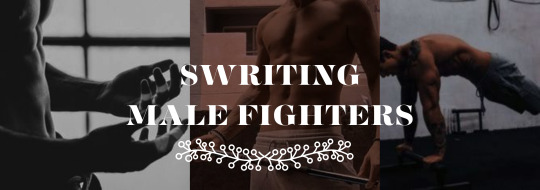
Writing Male Fighters
Body Language
Before they start fighting, they will communicate a lot through body language, either conscious or subconscious.
Standing with legs apart, elbows out to the side, shoulders aquared, chin thrust forward and up, hcest inflated and turned full front to his opponent, piercing stare. These cures are intended to make him bigger.
He may hook his hands into his belt, framing his genitals.
Subtly stretching his neck or spine.
Stepping close up to the other, invading the other person's personal space. The one who steps back will "lose" - when this happens, we know that fists will be flying soon.
Skills
When writing a scene from a male point of view, don't make the mistake of writing a detail about basic fighting skills (like landing a fist in the opponent's jaw). For a man (on average) who probably learnt to box in his playground days - it would be better to let the moves come naturally.
For fancier skills (like weapons handling or martial arts), you may explain in fuller detail so that your readers can follow what's happening.
Weapons
Men often have a special relationship with their weapon: very personal, almost intimate. The weapon may serve as a symbol of his power, masculinity and reflect his self-image, even.
The hero may be seen cleaning, repairing, oiling his weapon, bragging about it or comparing it with others'.
Men Against Women
Most men are reluctant to hurt a woman. This instinct is often hard-wired into them, even in martial arts school that pride themselves on gender equality.
While there is no biological reason for sparing a a female fighter - only the sense of good old chivalry - you can show your villain hesitate for a second or hit less hard when a see a woman coming for him.
If you like my blog, buy me a coffee☕ and find me on instagram! 📸
#writing#writers on tumblr#writers and poets#let's write#helping writers#poets and writers#writeblr#creative writing#creative writers#resources for writers#writing process#writing community#writing prompt#writing advice#writing ideas#writer#writerscommunity#writing inspiration#on writing#writer stuff#writer problems#writer on tumblr#writer things#writer community#author#writers block#writers community#writers life#male fighter#fight scene
1K notes
·
View notes
Text
BTS 1 — No edits with first postings
BTS (Behind the Scenes) 1 — No edits with first postings

I struggled with what version I would post the parts of the story up in. Edited or unedited. I decided on unedited. It’s a choice to be sure, it may be flawed (well it will be flawed) but it is the natural version of what I wrote. There in all its glory and stank.
I did some minor proofreading and spelling checks but outside of that, it’s all a seat of the pants writing in part 1. Scheduled to be published on Thursday. Meanwhile, I have the whole week to stress out about how it is going to work out, and what to publish in the meantime. So that’s why I’m here now. I’m writing about how the process goes. Step 1. Get excited by some new idea. Step 2. Write by the seat of your pants. Step 3. Stress. Obviously, this isn’t every single time but it's where I am now putting my whole process out there for the world to see.
I also need to admit that this whole process is different than my normal process by default because I’m putting it out there as serial fiction. This means I need to figure out good ways to break up the story for postings. I’m also struggling with the word count. I find myself asking how long should it be. Should I make it longer or shorter? I hope that the answers to these questions come naturally to me over time. But the first posting is only 1k, a super short read.
#writing#writer#author#writing process#author process#writing fiction#cyberpunk#dystopian#editing#editor
1 note
·
View note